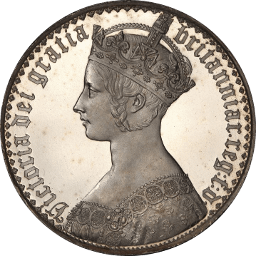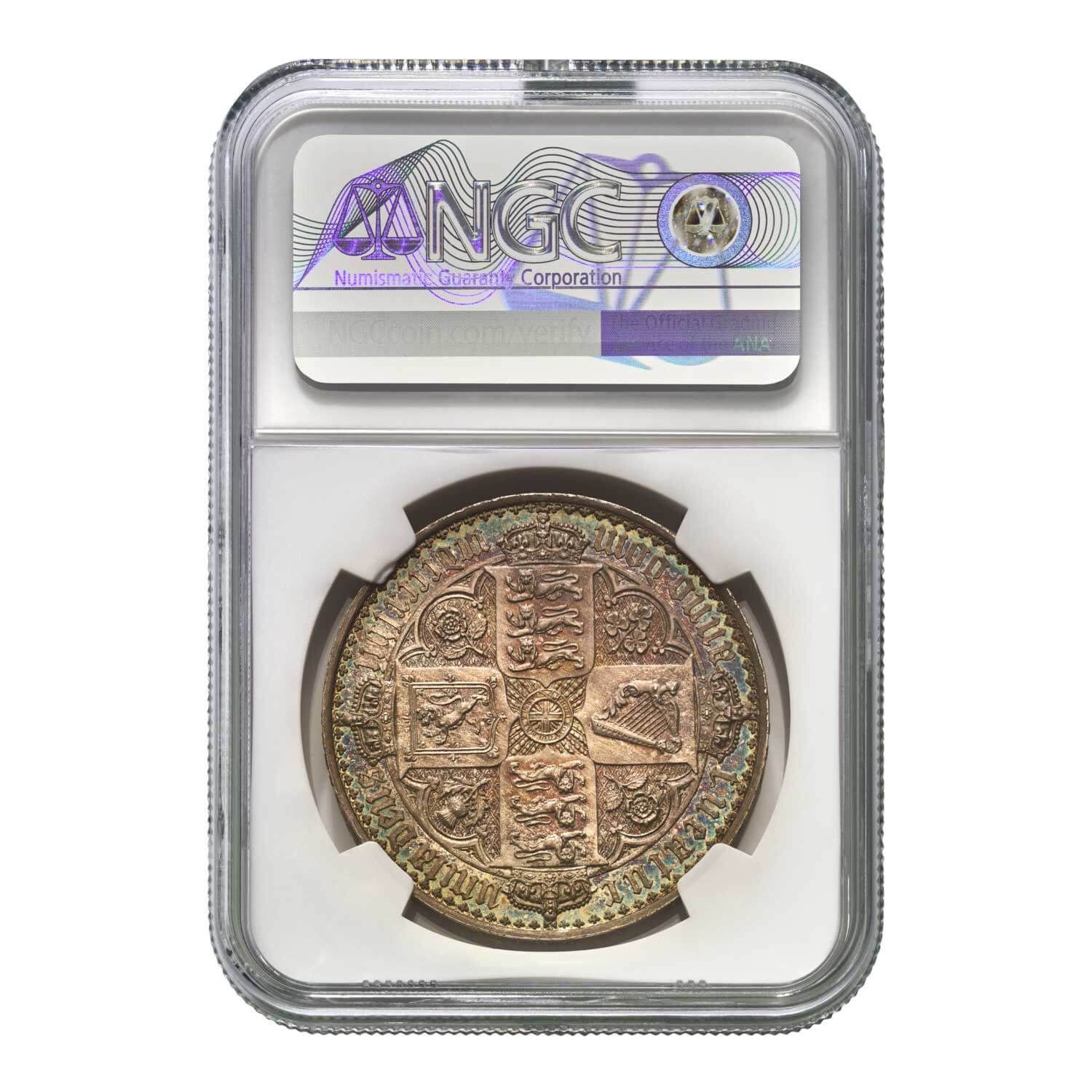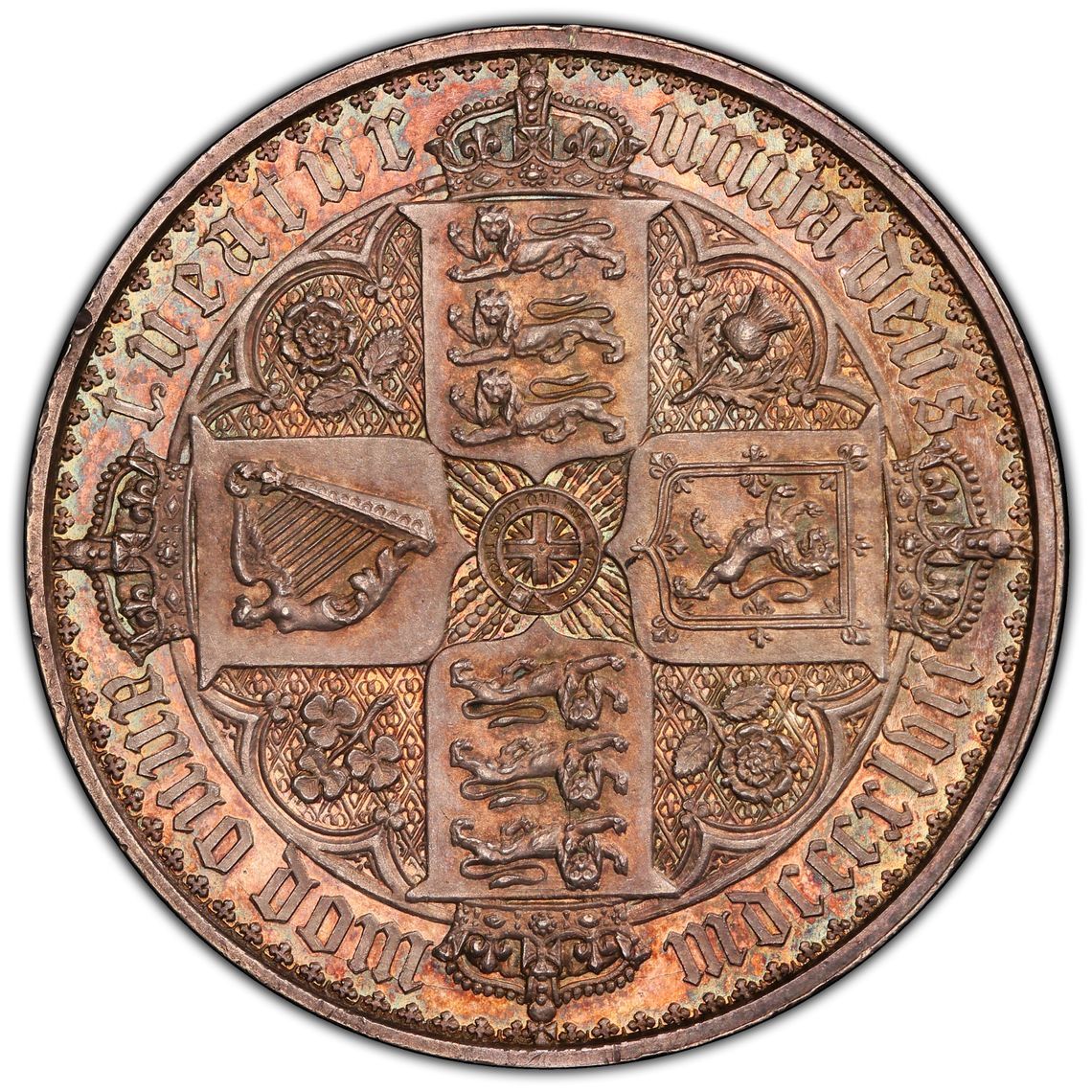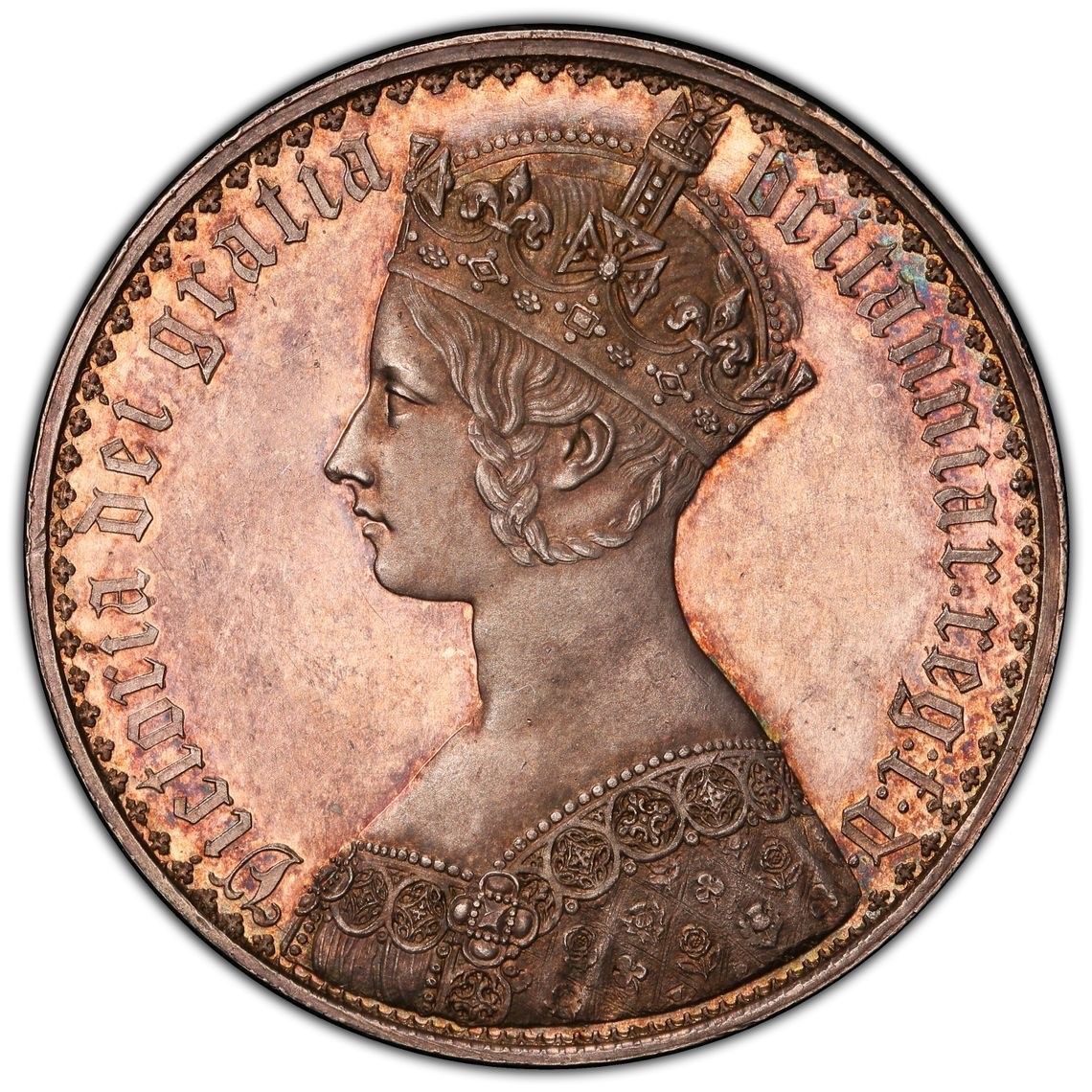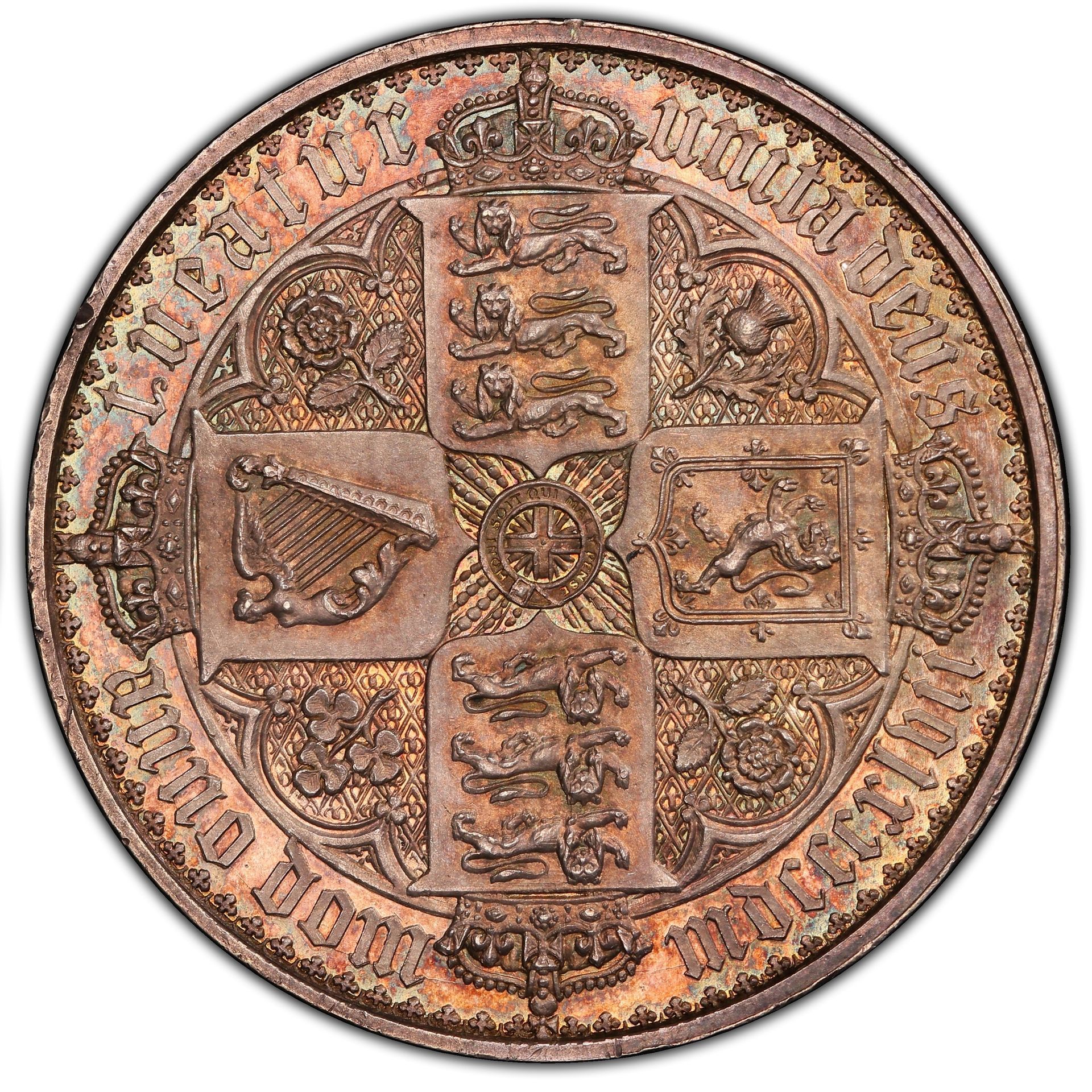Queen Victoria's "Gothic Crown" from 1847 had a mintage of just 8,000 and was produced to celebrate the gothic revival.
The Mysterious Tale of the 1847 Gothic Crown.
A Storied Relic of the Past - In the realm of numismatics, certain coins transcend their mere monetary value and become legendary artifacts that captivate collectors and historians alike. The 1847 Gothic Crown, a coin shrouded in mystery and beauty, is one such numismatic treasure. With its intricate design and elusive past, this Gothic Crown has become an object of fascination for enthusiasts all over the world.
William Wyon.
William Wyon RA’s Gothic Crown is one of the most beautiful coins ever struck .Produced by the chief engraver at the time "William Wyon" at the very peak of his successful career. Appreciated right away by Victorian numismatists and collected straight from the Bank of England, only 8,000 silver along with a 4-8 gold coins were struck, Many of which have been lost to time.
William Wyon: A Numismatic Luminary and His Profound Influence
William Wyon.
Numismatics, the study and collection of coins and currency, owes much of its artistic and historical significance to the contributions of remarkable individuals throughout history. Among these luminaries is William Wyon, an eminent British engraver of the 19th century. Wyon's exceptional talent, innovative techniques, and enduring legacy have left an indelible mark on the world of numismatics. This article explores the life, work, and lasting influence of William Wyon on the field of coinage.
Early Life and Education.
William Wyon was born on October 12, 1795, in Birmingham, England, into a family of renowned engravers. He received early guidance from his father, Peter Wyon, and later studied at the Royal Academy Schools in London. Wyon's innate artistic abilities soon became evident, and he quickly gained recognition for his skillful craftsmanship.
Royal Appointment and Career Milestones.
Wyon's career took a significant turn in 1828 when he was appointed Chief Engraver at the Royal Mint in London. This prestigious position allowed him to leave an indelible mark on the coinage of the British Empire. Among his notable achievements were the creation of iconic designs, including the Young Head portrait of Queen Victoria on coins during her early reign.
Portrait Engraving and Medallic Art.
Wyon possessed exceptional talent for capturing the likeness and character of his subjects. His portrait engravings displayed a remarkable level of detail and realism, setting new standards for coinage design. Notably, he produced the famous "Una and the Lion" design for the five-pound gold coin, representing Queen Victoria as Una from Edmund Spenser's poem "The Faerie Queene."
Technological Innovations.
Beyond his artistic prowess, Wyon was also an innovator in the realm of coinage production. He introduced new techniques, such as the "Wyon relief," which enhanced the aesthetic appeal of coins by creating a three-dimensional effect. He also pioneered the use of the "collar" to ensure consistent and accurate coin size and shape.
International Influence and Recognition.
Wyon's reputation extended far beyond the shores of Britain. His exceptional talent earned him recognition and commissions from various European monarchs, including the Russian Tsar Nicholas I and the King of Belgium, Leopold I. His coinage designs were renowned for their elegance and artistic excellence.
Legacy and Lasting Impact.
William Wyon's influence on numismatics cannot be overstated. His artistic achievements and technical innovations set new standards in coinage design. Many of his creations, such as the iconic "Bun Head" penny and the Gothic Crown, remain highly sought-after by collectors worldwide. Additionally, his artistic legacy influenced subsequent generations of engravers and artists, leaving an enduring impact on the field of numismatics.
William Wyon's remarkable talent, innovative techniques, and influential contributions have secured his place as one of the most revered figures in the history of numismatics. His exquisite coin designs and portrait engravings continue to captivate collectors and enthusiasts, reminding us of the enduring power of artistry and craftsmanship. Wyon's legacy serves as an inspiration for future generations, ensuring that his impact on the world of numismatics will be cherished and celebrated for years to come.
Within a decorated border, the obverse displays the youthful crowned bust of Victoria and is famously known as her "Gothic Portrait".
The 1847 Gothic Crown was designed by William Wyon, a renowned British engraver, and sculptor. It features a Gothic-inspired motif, which was a departure from the neoclassical style prevalent at the time.
The obverse of the coin showcases the youthful portrait of Queen Victoria, while the reverse displays a stunning rendition of a gothic-style crown. The intricate details and craftsmanship of this coin make it a true work of art.
"Only 8000
coins ever struck"
An Attractive investment for those both fascinated by history and numismatics.
01
Historical Significance
The 1847 Gothic Crown holds historical importance not only for its design but also for its connection to an important era in British history
02
Mysterious Origins
The coin was minted during the reign of Queen Victoria, a time when Britain was undergoing a transformation due to the Industrial Revolution.
03
Collectability and Value
Unsurprisingly, the 1847 Gothic Crown has become highly sought after by collectors. Due to its limited mintage, historical significance, and captivating design, this coin commands a significant premium in the numismatic market
04
Symbolism and Allegory
The gothic style reflected a revival of medieval architecture and aesthetics, which was a significant cultural shift during this period.
The 1847 Gothic Crown stands as a testament to the intricate artistry and historical significance of numismatic treasures.
Despite its historical significance, the 1847 Gothic Crown's origins remain somewhat enigmatic. The coin was never released for general circulation and was primarily produced as a commemorative piece. It is believed that only 8,000 of these coins were minted, adding to its scarcity and allure.
The reason behind its limited production and non-circulation status has puzzled collectors and researchers for years.
The numbers you need to know.
8000
Total coins struck in 1847.
28.23g
Weight of coin.
38.mm
Diameter.
67+
Best known graded example.
COMMEMORATE.
The coin was issued to commemorate the restoration of the medieval-style architecture of the Palace of Westminster (Houses of Parliament) in London, which was severely damaged by fire in 1834.
SYMBOLISM.
The gothic design of the coin represents a revival of medieval architecture and reflects the Victorian era's fascination with historical styles. It was a departure from the classical designs commonly seen on coins at the time.
VALUE.
Due to its rarity and historical significance, the 1847 Gothic Crown can be quite valuable to collectors. Its worth can vary depending on factors such as condition, rarity, and demand in the numismatic market.
623
PCGS Graded 1847 Proof Crowns
6
Different Varieties
-1%
Coins That Grade With Deep Cameo
-20%
Of Coins Struck submitted that have received grades through all grading company's
The Victorian Gothic period, spanning from the mid-19th century to the early 20th century.
An era marked by an intriguing blend of romanticism, darkness, and architectural grandeur. This period, characterized by its opulent structures, ornate detailing, and a fascination with the supernatural, left an indelible mark on history. In this article, we will delve into the enigmatic world of the Victorian Gothic period and explore its cultural, artistic, and architectural significance.
Cultural and Historical Context.
The Victorian Gothic period emerged during the reign of Queen Victoria (1837-1901), a time of rapid industrialization and societal change. It was a response to the neoclassical and Georgian architectural styles that dominated earlier periods. The Victorians sought to infuse their structures with a sense of drama, emotion, and a connection to the past.
Architectural Features.
Victorian Gothic architecture is characterized by its elaborate ornamentation, pointed arches, steeply pitched roofs, and intricate tracery. The use of dark-colored materials such as stone and brick, along with the inclusion of gargoyles, turrets, and spires, added a sense of mystery and drama to the buildings. Notable examples include the Houses of Parliament in London and the Manchester Town Hall.
Influence of Romanticism.
The Victorian Gothic period drew heavily from the Romantic movement, which celebrated individualism, passion, and the sublime. This influence is evident in the architecture, literature, and art of the time. Gothic novels, such as Mary Shelley's "Frankenstein" and Bram Stoker's "Dracula," captivated the public's imagination with their tales of horror, romance, and the supernatural.
Spiritualism and the Occult.
During the Victorian era, there was a growing interest in spiritualism and the occult. This fascination with the supernatural found expression in the Gothic architecture of the period. The inclusion of symbols, such as gargoyles and grotesques, was believed to ward off evil spirits and protect the buildings' inhabitants.
Revival of Medievalism.
The Victorian Gothic period marked a revival of interest in medieval architecture and craftsmanship. The Gothic Revival movement, championed by architects like Augustus Pugin, sought to recreate the grandeur and craftsmanship of the medieval period. This emphasis on intricate detailing and craftsmanship can be seen in the stained glass windows, wood carvings, and decorative plasterwork of Victorian Gothic structures.
The Victorian Gothic period stands as a testament to the Victorian era's fascination with the dark, the mysterious, and the sublime. Its architectural grandeur, influence from romanticism, and connection to the supernatural make it a captivating chapter in history. Today, the remnants of this period still inspire awe and admiration, reminding us of the enduring allure of the Victorian Gothic style.
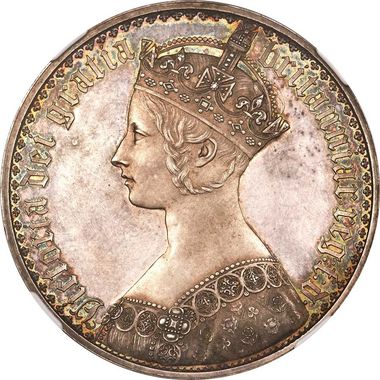
A TIMELESS SYMBOLIC COIN.
Symbolism and Allegory:
Beyond its exquisite design and limited mintage, the 1847 Gothic Crown carries a deeper symbolic meaning. The gothic-style crown depicted on the reverse serves as a metaphorical representation of the British monarchy's continuity and longevity. Its intricate details, such as the fleur-de-lis and the crosses, further emphasize the coin's symbolic significance.
1847 Crown Varieties.
The 1847 Gothic Crown, with its intricate design and historical significance, boasts several fascinating varieties. We will delve into two notable variations of the 1847 Gothic Crown, the Plain Edge and Letter Varieties. Let's uncover the unique characteristics and significance of each variation.
The Plain Edge Variety.
The Plain Edge variation of the 1847 Gothic Crown is a rarity that adds allure to any coin collection. Unlike its counterparts, this variety lacks the traditional raised inscription found on the edge of the coin. Instead, it features a smooth, plain edge, creating a distinct visual contrast. The absence of lettering on the edge adds uniqueness to this particular variant.
This variety is highly sought after by collectors due to its scarcity and aesthetic appeal. The absence of the raised lettering is believed to be a result a deliberate production variation. In 1847, the Gothic Crown coin was issued with different varieties, leading to confusion regarding the silver purity. Typically, plain edge gothic crowns of that time were made of sterling silver, which is 92.5% pure (or .925 fine silver). However, a small number of Gothic Crown coins were minted with a higher silver purity of .999 fine silver.
The confusion arises because both plain edge varieties of coins were produced in 1847, and it is difficult to distinguish between them based on their appearance alone. The majority of Gothic Crown coins from that year are sterling silver (.925 fine), but a handful of examples were struck using the higher .999 fine silver.
The reason behind this variation in silver purity is not entirely clear. It could be due to errors during the minting process or the intentional use of different silver compositions for experimental or commemorative VIP client purposes. Regardless, the existence of Gothic Crown coins with .999 fine silver content makes them extremely rare and highly sought after by collectors.
Examples have seen record breaking figures every time they rarely appear to the marketplace.
To identify the true silver purity of a specific Gothic Crown coin, it would require a thorough examination by experts who can detect the subtle differences in composition and by conducting scientific tests including x -ray analyses to see metal purity.
Letter edge Variety of the 1847 Gothic Crown
The Letter Variety of the 1847 Gothic Crown is another captivating variation that holds historical significance. Unlike the Plain Edge variation, this variant features raised lettering on the edge of the coin. The lettering typically includes the inscription "DECUS ET TUTAMEN," which translates to "An Ornament and a Safeguard."
It serves as a reminder of the Victorian era's meticulous attention to craftsmanship and symbolism. Collectors appreciate the Letter Variety for its unique combination of historical significance and aesthetic appeal.
The 1847 Gothic Crown is a remarkable coin that has captivated collectors for generations. Within its distinguished lineage, both the Plain Edge and Letter Varieties stand out as intriguing and highly sought collectors coins, These captivating coins serve as tangible reminders of the rich history and artistic excellence of the Victorian era.
Gothic Crown Market News.
Recent auction results. Coming Up soon. British Rarities.
Historic Auction Result.
Plain Edge 1847 Gothic Crown Sells for Record-breaking
$276,000.
In a remarkable display the recent Heritage Auction witnessed a world record-breaking sale of the Plain Edge 1847 Gothic Crown. This coveted numismatic treasure fetched an astounding price of $276,000 on 17.08 23, cementing its place in history as one of the most valuable Gothic Crowns ever sold. The previous record for a Gothic Crown sale stood at $186,000, achieved on May 3, 2022, making this latest auction result a truly momentous occasion for collectors and enthusiasts alike.
The Auction Event.
Heritage Auction, renowned for its prestigious sales of rare coins and collectibles, hosted the momentous event that culminated in the ground-breaking sale of the Plain Edge 1847 Gothic Crown. Bidders from around the world eagerly participated, recognizing the extraordinary opportunity to own a piece of history. The intense bidding competition witnessed during the auction is a testament to the desirability and scarcity of this exceptional coin.
Record-breaking Price.
As the gavel fell, the winning bid for the Plain Edge 1847 Gothic Crown PR66 DCAM reached an astonishing $276,000. This price shattered the previous record for a Gothic Crown sale, which stood at $186,000, achieved just over a year earlier. The substantial increase in value reflects the growing appreciation and demand for rare coins among collectors and investors. It also underscores the enduring allure of Gothic Crowns as a highly sought-after numismatic treasure.
Implications for Collectors and the Market.
The record-breaking auction result for the Plain Edge 1847 Gothic Crown has significant implications for both collectors and the wider numismatic market. The surge in value not only highlights the enduring appeal of rare coins but also reinforces the importance of historical context, rarity, and exceptional craftsmanship in determining their worth. This remarkable sale is likely to inspire renewed interest in the Gothic Crown series and drive further exploration of rare coins as a tangible investment.
The world record-breaking auction result of the Plain Edge 1847 Gothic Crown at the Heritage Auction, selling for an extraordinary $276,000 on August the 17th, 2023, represents a historic milestone in the realm of numismatics. This remarkable achievement underscores the enduring fascination and value placed on rare coins, while also serving as a testament to the craftsmanship and historical significance of the Gothic Crown series. As collectors and enthusiasts eagerly await the next chapter in the numismatic world, this record-breaking sale will undoubtedly be remembered as a defining moment in the pursuit of exceptional coins.
" The Soaring Value of the 1847 Gothic Crown Coin."
The past three years have witnessed an overall surge in interest and investment in rare coins. With traditional investment avenues facing uncertainties, many individuals have turned to tangible assets such as coins for their potential stability and long-term growth. The 1847 Gothic Crown, with its combination of historical allure and scarcity, has emerged as a prime candidate for investors looking to diversify their portfolios. This increased demand, coupled with a limited supply, has played a significant role in driving up the value of the coin.
In the ever-evolving world of numismatics, certain coins emerge as true gems, capturing the attention of collectors and investors alike. One such coin is the remarkable 1847 Gothic Crown. Over the past three years, this stunning piece of currency has experienced an unprecedented surge in value, captivating the numismatic community and reaffirming the enduring allure of rare and historical coins. lets delve into the fascinating journey of the 1847 Gothic Crown, exploring the factors behind its rapid increase in value.
Market Demand and Rarity.
One of the key drivers behind the rapid value increase of the 1847 Gothic Crown is the growing demand from collectors and investors. As the coin gains more recognition and notoriety, its desirability has skyrocketed. The limited mintage 8000 further amplifies its rarity, making it even more appealing to those seeking unique additions to their collections. The convergence of historical significance and scarcity has undoubtedly contributed to the remarkable surge in its value.
Record-Breaking Auctions.
The surge in value of the 1847 Gothic Crown has been further fuelled by record-breaking auction results. Numerous high-profile auctions have seen this coin achieve exceptional prices, often surpassing initial estimates. These remarkable sales have created a buzz within the numismatic community, attracting even more attention and contributing to the coin's growing allure. Collectors and investors alike are drawn to the potential for substantial returns on their investments, further solidifying the upward trajectory of the coin's value.
The Gothic Crown has experienced a truly remarkable journey over the past three years. Its rapid increase in value can be attributed to a variety of factors, including historical significance, increasing market demand, rarity, and record-breaking auction results. As the numismatic market continues to evolve the 1847 Gothic Crown is likely to remain highly sought after. For collectors and investors alike,
Gothic Crown Coin Archive.
Welcome to GothicCrown.com Coin Archive, the ultimate online resource for collectors and enthusiasts of the iconic Gothic Crown coin. Our website is dedicated to preserving the rich history and artistic beauty of this remarkable numismatic treasure.
At Gothic Crown Coin Archive, you'll find a comprehensive collection of information, images, and historical data related to Gothic Crown coins. Whether you're a seasoned collector or just starting your numismatic journey, our website offers a wealth of resources to satisfy your curiosity and deepen your understanding of these exquisite coins.
Explore our soon to be extensive catalogue of 1847 Gothic crowns from various different auction houses, which features high-resolution images and detailed descriptions of various Gothic Crown coin variants. From the earliest editions to the rarest and most sought-after releases, we strive to provide a complete overview of this fascinating coin series.
We also foster a vibrant community of collectors who share a passion for Gothic Crown coins. Engage in discussions, share your insights, and connect with like-minded individuals who appreciate the beauty and historical significance of these coins.
Whether you're seeking to expand your collection, learn more about Gothic Crown coins, or simply indulge in their captivating beauty, Gothic Crown Coin Archive is your go-to destination. Start your exploration today and delve into the mesmerizing world of these exquisite numismatic treasures.
